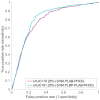Multi-feature based Benchmark for Cervical Dysplasia Classification Evaluation
- PMID: 28603299
- PMCID: PMC5464748
- DOI: 10.1016/j.patcog.2016.09.027
Multi-feature based Benchmark for Cervical Dysplasia Classification Evaluation
Abstract
Cervical cancer is one of the most common types of cancer in women worldwide. Most deaths due to the disease occur in less developed areas of the world. In this work, we introduce a new image dataset along with expert annotated diagnoses for evaluating image-based cervical disease classification algorithms. A large number of Cervigram® images are selected from a database provided by the US National Cancer Institute. For each image, we extract three complementary pyramid features: Pyramid histogram in L*A*B* color space (PLAB), Pyramid Histogram of Oriented Gradients (PHOG), and Pyramid histogram of Local Binary Patterns (PLBP). Other than hand-crafted pyramid features, we investigate the performance of convolutional neural network (CNN) features for cervical disease classification. Our experimental results demonstrate the effectiveness of both our hand-crafted and our deep features. We intend to release this multi-feature dataset and our extensive evaluations using seven classic classifiers can serve as the baseline.
Keywords: Cervical cancer screening; computer aided diagnosis; convolutional neural network; image classification; local binary patterns; pyramid histogram.
Figures






References
-
- WHO. Summary report, ICO Information Centre on HPV and Cancer. Aug, 2014. Human papillomavirus and related cancers in the world.
-
- Kim E, Huang X. A data driven approach to cervigram image analysis and classification. Color Medical Image analysis, Lecture Notes in Computational Vision and Biomechanics. 2013;6:1–13.
-
- Sankaranarayanan R, Gaffikin L, Jacob M, et al. A critical assessment of screening methods for cervical neoplasia. International Journal of Gynecology and Obstetrics. 2005;89:4–12. - PubMed
-
- Biscotti CV, Dawson AE, et al. Assisted primary screening using the automated thinprep imaging system. American Journal of Clinical Pathology. 2005;123(2):281–287. - PubMed
-
- Wilbur DC, Black-Schaffer WS, Luff RD, et al. The becton dickinson focalpoint gs imaging system: Clinical trials demonstrate significantly improved sensitivity for the detection of important cervical lesions. American Journal of Clinical Pathology. 2009;132(5):767–775. - PubMed
Grants and funding
LinkOut - more resources
Full Text Sources
Other Literature Sources
